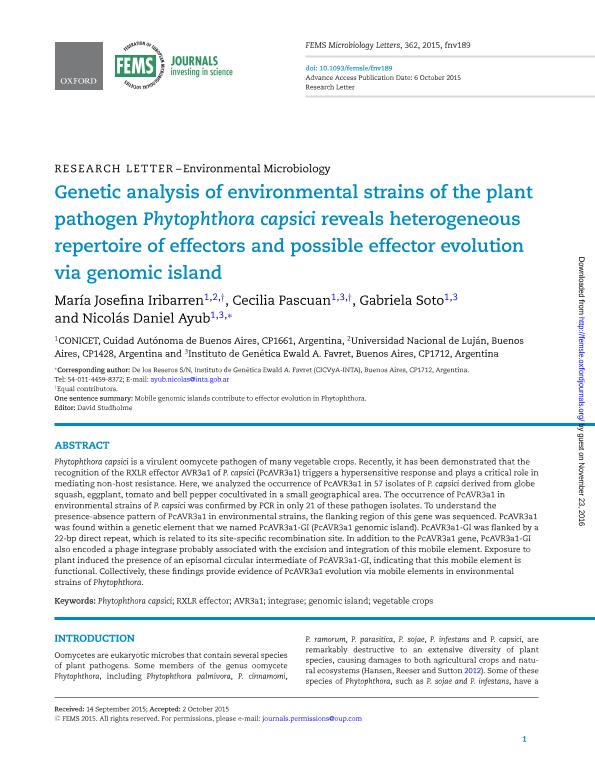Mostrar el registro sencillo del ítem
dc.contributor.author
Iribarren, María Josefina

dc.contributor.author
Pascuan, Cecilia Gabriela

dc.contributor.author
Soto, Gabriela Cynthia

dc.contributor.author
Ayub, Nicolás Daniel

dc.date.available
2020-09-08T20:38:35Z
dc.date.issued
2015-10
dc.identifier.citation
Iribarren, María Josefina; Pascuan, Cecilia Gabriela; Soto, Gabriela Cynthia; Ayub, Nicolás Daniel; Genetic analysis of environmental strains of the plant pathogen Phytophthora capsici reveals heterogeneous repertoire of effectors and possible effector evolution via genomic island; Wiley Blackwell Publishing, Inc; FEMS Microbiology Letters; 362; 22; 10-2015; 1-6
dc.identifier.issn
0378-1097
dc.identifier.uri
http://hdl.handle.net/11336/113562
dc.description.abstract
Phytophthora capsici is a virulent oomycete pathogen of many vegetable crops. Recently, it has been demonstrated that the recognition of the RXLR effector AVR3a1 of P. capsici (PcAVR3a1) triggers a hypersensitive response and plays a critical role in mediating non-host resistance. Here, we analyzed the occurrence of PcAVR3a1 in 57 isolates of P. capsici derived from globe squash, eggplant, tomato and bell pepper cocultivated in a small geographical area. The occurrence of PcAVR3a1 in environmental strains of P. capsici was confirmed by PCR in only 21 of these pathogen isolates. To understand the presence-absence pattern of PcAVR3a1 in environmental strains, the flanking region of this gene was sequenced. PcAVR3a1 was found within a genetic element that we named PcAVR3a1-GI (PcAVR3a1 genomic island). PcAVR3a1-GI was flanked by a 22-bp direct repeat, which is related to its site-specific recombination site. In addition to the PcAVR3a1 gene, PcAVR3a1-GI also encoded a phage integrase probably associated with the excision and integration of this mobile element. Exposure to plant induced the presence of an episomal circular intermediate of PcAVR3a1-GI, indicating that this mobile element is functional. Collectively, these findings provide evidence of PcAVR3a1 evolution via mobile elements in environmental strains of Phytophthora.
dc.format
application/pdf
dc.language.iso
eng
dc.publisher
Wiley Blackwell Publishing, Inc

dc.rights
info:eu-repo/semantics/openAccess
dc.rights.uri
https://creativecommons.org/licenses/by-nc-sa/2.5/ar/
dc.subject
PHYTOPHTHORA CAPSICI
dc.subject
RXLR EFFECTOR
dc.subject
AVR3A1
dc.subject
INTEGRASE
dc.subject
GENOMIC ISLAND
dc.subject
VEGETABLE CROPS
dc.subject.classification
Genética y Herencia

dc.subject.classification
Ciencias Biológicas

dc.subject.classification
CIENCIAS NATURALES Y EXACTAS

dc.title
Genetic analysis of environmental strains of the plant pathogen Phytophthora capsici reveals heterogeneous repertoire of effectors and possible effector evolution via genomic island
dc.type
info:eu-repo/semantics/article
dc.type
info:ar-repo/semantics/artículo
dc.type
info:eu-repo/semantics/publishedVersion
dc.date.updated
2020-09-08T19:53:24Z
dc.journal.volume
362
dc.journal.number
22
dc.journal.pagination
1-6
dc.journal.pais
Reino Unido

dc.journal.ciudad
Londres
dc.description.fil
Fil: Iribarren, María Josefina. Universidad Nacional de Luján; Argentina. Consejo Nacional de Investigaciones Científicas y Técnicas; Argentina
dc.description.fil
Fil: Pascuan, Cecilia Gabriela. Instituto Nacional de Tecnología Agropecuaria. Centro de Investigación en Ciencias Veterinarias y Agronómicas. Instituto de Genética; Argentina. Consejo Nacional de Investigaciones Científicas y Técnicas; Argentina
dc.description.fil
Fil: Soto, Gabriela Cynthia. Consejo Nacional de Investigaciones Científicas y Técnicas; Argentina. Instituto Nacional de Tecnología Agropecuaria. Centro de Investigación en Ciencias Veterinarias y Agronómicas. Instituto de Genética; Argentina
dc.description.fil
Fil: Ayub, Nicolás Daniel. Consejo Nacional de Investigaciones Científicas y Técnicas; Argentina. Instituto Nacional de Tecnología Agropecuaria. Centro de Investigación en Ciencias Veterinarias y Agronómicas. Instituto de Genética; Argentina
dc.journal.title
FEMS Microbiology Letters

dc.relation.alternativeid
info:eu-repo/semantics/altIdentifier/doi/http://dx.doi.org/10.1093/femsle/fnv189
dc.relation.alternativeid
info:eu-repo/semantics/altIdentifier/url/https://academic.oup.com/femsle/article/362/22/fnv189/1816015
Archivos asociados
